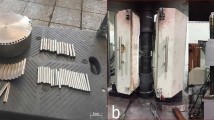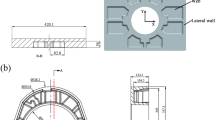Abstract
The preform billet shape of the 7050 aluminum alloy giant plane forgings has been designed using electric field method based on similarity principle. Firstly, the electrostatic field was analysed by using ANSYS software, from which the preform billet shape was obtained based on electrostatic field equipotential lines. The preform shape, press velocity, temperature and friction factor were taken as parameter variables, while the forming load, filling rate and grain size were chosen as optimization goals. The mathematical model was optimized by the use of a Model-Based Calibration (MBC) toolbox for modelling, Three-Dimensional of Design Environment for FORMing (DEFORM-3D) for simulation and CAlibration GEneration (CAGE) toolbox, obtaining the best preform shape and the optimal combination of process parameters (friction factor μ = 0.2, press velocity ν = 9.8 mm/s and billet temperature T = 478 °C) when the equipotential line was ξ = 0.425 V. Finally, comparing with initial preform shape, the results indicate that the optimized preform billet designed by electric field method has an advantage in finish forging, while the forming load of finish forging reduces by about 38 % and the average micrograin size reduces by about 45 %. Therefore, it provides an effective method for designing preform billet shape of complex forgings.
Similar content being viewed by others
References
Zhao XH, Zhao GQ, Wang GH (2000) The current situation and development of preform design in bulk metal forming. J Plast Eng 7(3):1–6
Pack JJ, Rebelo N, Kobayshi S (1983) A new approach to preform design in metal forming with the finite element method. Int J Mach Tool Des Res 23(1):71–79
Tang YC, Zhou XH, Chen J (2008) Preform tool shape optimization and redesign based on neural network response surface method-ology. Finite Elem Anal Des 44(8):462–471
Ma XW, Zhao XH, Zhao GQ, Wang GC (1999) Optimal preform die shapes design using sensitivity analysis based finite element method. Mater Sci Technol 7:96–99
Sedighi M, Tokmechi S (2008) A new approach to preform design in forging process of complex parts. J Mater Process Technol 197(1/3):314–324
Lee SR, Lee YK, Park CH, Yang DY (2002) A new method of preform design in hot forging by using electric field theory. Int J Mech Sci 44(4):773–792
Zhang RP, Li FG, Xiao J (2007) Isothermal forging pre-forming design of PM super alloy disc based on equipotential field. Hot Work Technol 36(9):70–74
Li C (2005) Study on similar equipotential - field simulation method in materials processing engineering. Northwestern Polytechnical University, Master’s Thesis, pp 13–17
Xiao J, Li FG (2006) Equipotential field simulation for the gas pressure superplastic bulging of axisymmetrical circular sheets. J Plast Eng 13(2):14–19
Ko DC, Kim DH, Kim BM, Choi JC (1998) Methodology of preform design considering workability in metal forming by the artificial neural network and Taguchi method. J Mater Process Technol 80–81:487–492
Poursina M, Arvizian J, Antonio C (2006) Optimum pre-form dies in two-stage forging. J Mater Process Technol 174(1/3):325–333
Özdemir M, Ergin AA (2006) Rotations with unit time like quatemions in Minkowski 3-space. J Geom Phys 56(2):322–336
Zhang Q, Hu RX, Kang ST (2010) Electromagnetic finite element analysis from entry to the master of ANSYSl2.0 (in Chinese). Beijing Mechanical Industry Press
Xie HG, Xu L, Wang H, Jiang SM, Fang LF, Tang J (2008) The research of three 3D reconstruction methods of Mimics V10. 0 software. Med J West China 20(5):1089–1091
Zhao XH, Zhao GQ, Wang GC, Wang TH (2002) Research on the shape optimization of billet in metal forging process. Forging Stamping Technol 27(02):3–5
Rong QE, Cheng CW (2002) Latin hyper cube sampling in ultimate strength reliability of ship hull grider. J Ship Mech 3:52–57
Jie Z, Lei L, Yan L (2014) The multi-objective optimization design of a new closed extrusion forging technology for a steering knuckle with long rod and fork. Int J Adv Manuf Technol 72:1219–1225
Jie Z, Yu YY, Zeng Q (2014) Analysis and experimental studies of internal voids in multi-wedge cross wedge rolling stepped shaft. Int J Adv Manuf Technol 72:1559–1566
Ho T, Karri V (2011) Hydrogen powered car: two-stage modeling system. Int J Hydrog Energy 36:10065–10079
Author information
Authors and Affiliations
Corresponding author
Additional information
Foundation item: Natural Science Foundation of China (no. 51275543) and major special projects of Chinese Ministry of Science & Technology (no. 2012ZX04010-081)
Rights and permissions
About this article
Cite this article
Tao, Y., Zhou, J., Cao, J. et al. Optimization design preform billet shape of 7050 aluminum alloy giant plane forgings based on electric field method and MBC toolbox. Int J Adv Manuf Technol 81, 231–240 (2015). https://doi.org/10.1007/s00170-015-7149-4
Received:
Accepted:
Published:
Issue Date:
DOI: https://doi.org/10.1007/s00170-015-7149-4




